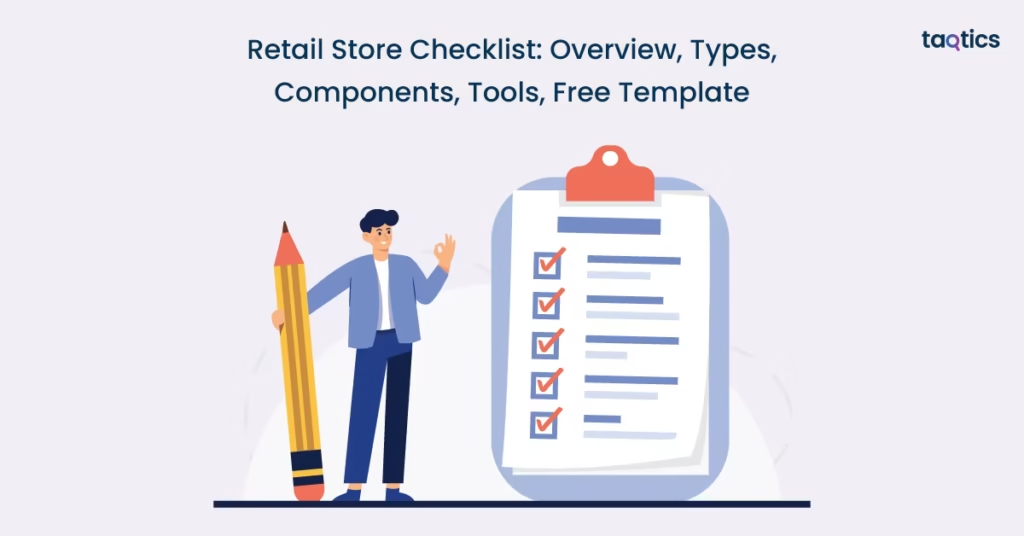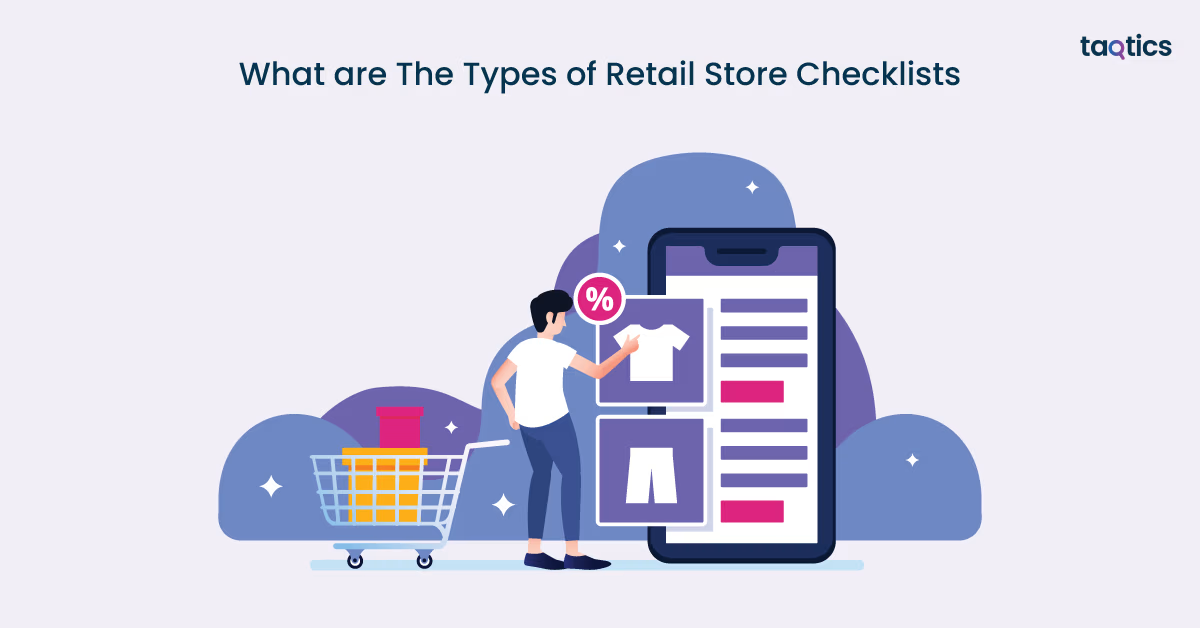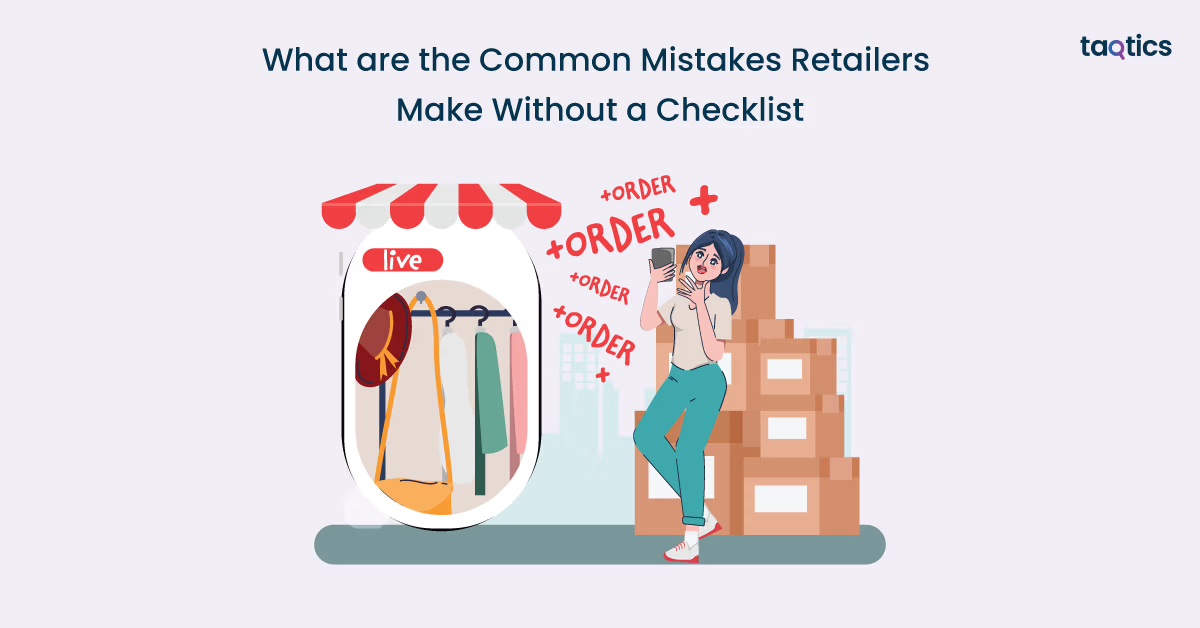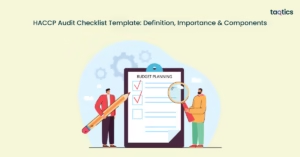Retail Store Checklist: Overview, Types, Components, Tools, Free Template

Retail store checklists are foundational tools that drive operational excellence, ensure compliance, and elevate the customer experience in today’s competitive retail landscape. Retail store checklists cover key areas that include visual merchandising, inventory management, cleanliness, safety, employee performance, and customer service.
For example, a leading apparel retailer implemented a daily opening checklist covering tasks such as verifying stock levels, inspecting displays, and ensuring POS systems are operational. Within three months, the retailer reported a 15% improvement in customer satisfaction scores and a 10% reduction in stock discrepancies, attributed directly to consistent checklist adherence.
According to a study by SafetyCulture, implementing structured checklists in retail environments can significantly improve efficiency and accountability among staff members. By leveraging digital tools and templates, retailers can streamline audits, capture real-time data, and generate actionable insights, further enhancing store performance.
What is a Retail Store Checklist?
A retail store checklist is a structured list of essential tasks and inspections that need to be performed regularly-typically daily, before opening the store or after closing it. Its purpose is to ensure consistency in store operations, maintain cleanliness, optimize efficiency, and enhance customer satisfaction. These checklists cover a wide range of activities such as security and safety checks, verifying the functionality of point-of-sale (POS) systems, inspecting store cleanliness, organizing merchandise displays, and confirming adequate stock levels.
According to a SafetyCulture study, retail stores that implement digital checklists report a 30–50% increase in task completion accuracy and a 25% improvement in operational efficiency. For growing brands, it ensures scalable and repeatable processes across locations. By following a retail store checklist, businesses can standardize processes, reduce errors, and create a welcoming shopping environment that meets both operational standards and customer expectations.
Why a Retail Store Checklist Is Essential
A retail store checklist is essential fas it directly impacts operational efficiency, brand consistency, and regulatory compliance.
- Preventing Oversight in Daily Tasks: Retail environments are fast-paced, and it’s easy for staff to overlook routine but crucial activities. A standardized checklist ensures that all necessary tasks-such as inventory checks, cleaning, and security protocols-are completed each day, reducing the risk of missed steps and operational errors.
- Maintaining Visual and Service Consistency: Checklists help enforce brand standards across multiple locations by guiding staff on visual merchandising, store layout, and customer service expectations. This consistency strengthens brand identity and delivers a uniform shopping experience for customers, regardless of which location they visit.
- Aiding Training and Team Accountability: By clearly outlining daily responsibilities, checklists serve as effective training tools for new employees and help set clear expectations for all staff. They also foster accountability, as managers can track task completion and identify areas where additional support or coaching may be needed.
- Supporting Audit Readiness and Compliance: Checklists facilitate regular audits by providing a documented record of completed tasks and compliance with company policies and regulatory requirements. This not only helps identify and address gaps proactively but also ensures the store is always prepared for official inspections, minimizing the risk of fines or reputational damage.
A retail store checklist streamlines operations, minimizes risk, and supports continuous improvement, making it indispensable for any retail business aiming for operational excellence.
What Should be Included in a Retail Store Checklist?
Seven components should be included in a retail store checklist.
Before Opening Checklist
The process begins with unlocking the store and securing access, which involves checking all entry points for signs of tampering and ensuring only authorized staff enter the premises.
- Once inside, staff should activate the store’s lighting, music, and climate controls to create a welcoming and comfortable environment for both customers and employees.
- Cleanliness and sanitation are next on the list, requiring a thorough inspection and cleaning of all customer-facing and staff areas, including floors, windows, restrooms, and product displays, to uphold hygiene and presentation standards.
- It’s also essential to check all POS terminals, making sure registers, card readers, and barcode scanners are powered on and functioning properly to avoid transaction delays.
- Counting the float money and verifying cash drawer balances ensures that each register is prepared for the day’s transactions and that cash handling is accurate and secure.
- Finally, a brief team meeting should be held to communicate daily goals, assign specific roles and responsibilities, and address any important updates or promotions.
By diligently following this checklist, retail stores can ensure operational readiness, minimize disruptions, and provide a consistent, high-quality experience for every customer from the moment the doors open.
During the Day Checklist
This checklist typically begins with inventory restocking, where staff regularly replenish shelves and displays to ensure popular and fast-moving items remain available, minimizing the risk of stockouts and lost sales.
- Customer service monitoring is another key focus, as team members should actively engage with shoppers, address inquiries, and resolve issues promptly to uphold high service standards and gather valuable feedback.
- During periods of low footfall, staff should follow a clean-up routine-tidying shelves, wiping surfaces, and keeping the store environment neat to enhance the shopping experience.
- Checking promotions and displays is also essential; employees must verify that promotional materials and product displays are accurate, attractive, and aligned with current campaigns, making adjustments as needed to maximize impact.
- Efficiently handling returns and exchanges ensures customer satisfaction and maintains inventory accuracy, requiring staff to follow established procedures for processing and restocking returned items.
- Lastly, monitoring security systems throughout the day helps safeguard store assets, prevent theft, and ensure a safe environment for both staff and customers.
By systematically addressing these areas, retailers can maintain operational excellence and foster a positive, trustworthy shopping atmosphere.
Before Closing Checklist
The process starts with counting and reconciling cash in each register, where staff meticulously tally the day’s takings and match them against sales receipts, preparing deposits and securing funds to prevent discrepancies or losses.
- The store layout must be cleaned and reset, which involves tidying shelves, organizing displays, and ensuring all areas, including fitting rooms and restrooms, are spotless and inviting for the following day.
- Locking the stockroom and back office is a critical security step, ensuring that inventory and sensitive information are safely secured overnight.
- Reviewing daily KPIs, such as sales figures and inventory movement, allows managers to assess performance, identify trends, and address any issues before closing out the day.
- Finally, a team debrief provides an opportunity to discuss the day’s highlights and challenges, while also assigning prep tasks for the next day, ensuring everyone is aligned and the store is set up for a smooth opening.
This comprehensive approach to closing not only protects the business but also supports operational consistency and team accountability.
Including these components in a retail store checklist ensures operational consistency, enhances customer experience, and supports compliance and audit readiness.
What are The Types of Retail Store Checklists?
The types of retail store checklists include daily, weekly, and monthly store checklists.

Daily Retail Store Checklist
It is a structured list of essential tasks, covering procedures for opening and closing the store, managing cash and inventory, maintaining cleanliness, and organizing staff, all of which contribute to operational efficiency and customer satisfaction.
- Store opening procedures: Unlock and secure the store, deactivate alarm systems, turn on lights and HVAC, inspect for overnight issues, and ensure the premises are safe and ready for business.
- Cash register & POS setup: Prepare registers with the correct cash float, power on and test POS systems, verify payment devices, and process a test transaction to ensure smooth sales operations.
- Cleanliness & safety: Clean the sales floor, restrooms, and fitting rooms; check for hazards like spills or debris; and confirm all safety protocols and equipment are in place to protect staff and customers.
- Staff briefing & scheduling: Review employee schedules, conduct a team briefing to discuss daily goals, promotions, and assign specific roles or responsibilities for the day.
- Stock check and replenishment: Restock shelves, organize inventory deliveries, rotate products, and verify that all items are properly displayed and available for customers.
- Merchandising and displays: Ensure all signage, promotional materials, and product displays are accurate, attractive, and aligned with current campaigns or seasonal themes.
- Store closing tasks: Count and reconcile cash, close and secure registers, clean and reset the store layout, lock stockrooms and offices, review daily KPIs, and assign prep tasks for the next day.
By systematically following this checklist, retailers can ensure operational consistency, minimize risks, and create a welcoming environment that supports business success.
Weekly Retail Store Checklist
A Weekly Retail Store Checklist is a structured guide that helps managers and staff address broader operational and performance tasks that go beyond daily routines. By focusing on these weekly priorities, stores can maintain optimal inventory levels, ensure a high standard of cleanliness, foster team alignment, and track progress toward business goals.
- Inventory review: Conduct a thorough count and audit of inventory to identify discrepancies, monitor stock levels, check for expired or damaged products, and verify that all items are accurately recorded in inventory systems.
- Deep cleaning tasks: Perform intensive cleaning of areas not covered in daily routines, such as scrubbing floors, cleaning storage spaces, dusting fixtures, and sanitizing high-touch surfaces to maintain a safe and inviting environment.
- Team meetings and performance review: Hold weekly meetings to discuss team performance, review sales results, address challenges, provide feedback, and align on upcoming goals or promotions, ensuring everyone is informed and motivated.
- Sales & KPI tracking: Analyze weekly sales data and key performance indicators (KPIs) such as revenue, customer satisfaction, and inventory turnover to assess progress, identify trends, and inform strategic decisions for continuous improvement.
Regularly following a weekly checklist enables retail stores to stay organized, address issues proactively, and drive sustained business success.
Monthly Retail Store Checklist
A Monthly Retail Store Checklist is a structured tool used to address critical operational, maintenance, and strategic tasks that require attention on a monthly basis. This checklist helps managers ensure the store runs efficiently, remains compliant, and is prepared for future business opportunities by focusing on in-depth reviews, maintenance, staff development, and financial planning.
- Inventory audit: Conduct a thorough physical count of inventory, reconcile records with actual stock, identify discrepancies, and investigate causes of shrinkage or overstock to maintain inventory accuracy and reduce losses.
- Equipment maintenance: Inspect and service key equipment such as HVAC, POS systems, refrigeration units, and safety devices. Address any maintenance needs, perform preventive checks, and document completed tasks to avoid unexpected breakdowns and ensure operational continuity.
- Staff evaluations: Review employee performance, provide feedback, set new goals, and identify training needs. This process helps recognize top performers, address areas for improvement, and align the team with store objectives.
- Financial reporting: Prepare monthly financial statements, analyze sales, expenses, and profitability, and compare results to targets. Use these insights to inform decision-making and adjust business strategies as needed.
- Promotions planning: Assess the effectiveness of past promotions, plan upcoming campaigns, and coordinate with suppliers or marketing teams. Update merchandising and displays to align with new promotional activities and drive customer engagement.
By following a monthly checklist, retail stores can proactively manage operations, maintain high standards, and position themselves for ongoing success.
Now when the types are known, let us check out the components now.
What are the Key Components of a Retail Store Checklist?
The key components of a retail store checklist are designed to ensure operational efficiency, a positive customer experience, and compliance with safety and brand standards. Here’s how each element contributes to a comprehensive checklist:
Store appearance & cleanliness
Maintaining a clean, organized, and visually appealing environment is crucial for customer satisfaction and brand perception. Tasks include cleaning floors, windows, restrooms, and displays, replacing signage as needed, and ensuring the checkout area is tidy and inviting.
Customer service readiness
Staff should be prepared to greet and engage customers, communicate effectively, and resolve issues promptly. This involves training employees on customer interaction, ensuring they are knowledgeable about products and policies, and regularly reviewing service quality to deliver a consistent and exceptional experience.
Inventory & supply levels
Regularly checking and restocking shelves prevents stockouts and overstocking. Inventory audits, quality control, and organized storage help maintain accurate records and product availability, directly impacting sales and customer trust14.
Security systems check
Verifying that security cameras, alarm systems, and access controls are operational protects assets and ensures the safety of staff and customers. This includes monitoring entry points, securing stockrooms, and preparing for emergencies with up-to-date protocols.
Technology (POS, payment systems)
Ensuring point-of-sale (POS) systems, payment terminals, and related technology are functioning is essential for smooth transactions. This also includes updating software, checking for connectivity issues, and confirming that all payment options are available to customers.
Health & safety compliance
Regular inspections for hazards, proper sanitation, and adherence to safety regulations protect both employees and customers. This includes checking fire alarms, first aid kits, emergency exits, and ensuring the store is free from potential risks.
Visual merchandising consistency
Product displays, signage, and promotions should be arranged according to brand guidelines. Regular checks ensure displays are attractive, accurate, and align with current campaigns, maximizing sales opportunities and reinforcing brand identity.
Together, these components form the backbone of an effective retail store checklist, supporting daily operations, customer satisfaction, and long-term business success.
How to Customize Your Retail Checklist?
To customize your retail checklist, you can adopt strategies that align perfectly with your store’s unique operations, goals, and challenges.
1. Assess Your Store’s Specific Needs
Start by analyzing your store’s size, product range, customer traffic, and operational complexity. For example, a clothing store will have different merchandising and inventory needs compared to a grocery store. Identify critical daily, weekly, and monthly tasks unique to your business.
2. Involve Your Team
Engage store managers and frontline employees in the customization process. Their hands-on experience provides valuable insights into practical challenges and essential tasks that should be included. This also promotes ownership and adherence to the checklist.
3. Prioritize Key Areas
Focus on areas that impact customer experience, safety, and sales the most. Customize sections such as visual merchandising, inventory management, and customer service protocols to reflect your brand standards and operational priorities.
4. Incorporate Technology and Tools
If your store uses specific software or devices (e.g., advanced POS systems, inventory management apps), include checks related to these technologies. This ensures smooth integration of digital tools into daily operations.
5. Define Frequency and Responsibility
Specify how often each task should be performed—daily, weekly, or monthly—and assign clear responsibility to team members. This clarity helps avoid confusion and ensures accountability.
6. Allow Flexibility for Seasonal or Promotional Changes
Retail environments often shift with seasons or campaigns. Customize your checklist to include tasks related to setting up promotions, seasonal displays, or special events, and update it regularly to stay relevant.
7. Use Templates and Digital Formats
Leverage customizable checklist templates or digital checklist apps that allow easy editing and real-time tracking. This facilitates updates, data collection, and performance monitoring.
8. Review and Update Regularly
Periodically review the checklist’s effectiveness and update it based on feedback, audit results, or changes in store operations. Continuous improvement keeps the checklist aligned with evolving business needs.
By thoughtfully customizing your retail checklist, you create a practical, focused tool that enhances daily operations, boosts team productivity, and ultimately drives better customer experiences and business outcomes.
What are the Common Mistakes Retailers Make Without a Checklist?
The common mistakes that retailers make without a checklist impact efficiency, customer satisfaction, and profitability.

- Overlooking critical daily tasks: Without a checklist, essential activities such as opening and closing procedures, equipment checks, and cash reconciliation are often forgotten or inconsistently performed, leading to operational disruptions and security risks.
- Inconsistent store appearance and merchandising: Failure to regularly verify visual merchandising standards and promotional displays results in a disorganized store environment that can confuse customers and reduce sales effectiveness.
- Poor inventory management: Lack of systematic inventory checks often causes stockouts, overstocking, or expired products, which directly affect sales and cash flow. Disorganized stockrooms and inaccurate inventory records are common consequences without checklist discipline.
- Inadequate customer service readiness: Without a customer service checklist, staff may miss key interactions such as greeting customers or handling complaints properly, leading to a diminished shopping experience and lost loyalty.
- Neglecting health, safety, and security protocols: Important safety checks, such as fire alarm testing or security system monitoring, can be overlooked, increasing the risk of accidents, theft, or regulatory non-compliance.
- Technology failures: Regular POS and payment system checks are often missed, causing transaction delays or failures that frustrate customers and disrupt sales.
- Lack of accountability and training gaps: Without clear task assignments and checklist-driven processes, staff accountability suffers, and training needs may go unnoticed, impacting overall store performance.
Implementing standardized checklists helps retailers maintain consistency, improve accountability, and proactively address issues before they escalate.
What Tools can Automate Retail Store Checklist?
There are 7 common tools that can automate retail store checklists, streamlining operations, improving accuracy, and saving time for store managers and staff.
- Taqtics: Purpose-built for retail and restaurant operations, Taqtics is a no-code platform that enables retailers to create, schedule, and assign both ad-hoc and recurring checklists. It digitizes SOPs, automates daily tasks, and provides real-time alerts, escalations, and reports. It also features mobile-based learning, centralized document sharing, GPS-based clock-ins, and a digital dashboard for instant visibility across all stores. Its automated reminders, workflow assignments, and visual merchandising review tools help teams stay compliant, productive, and audit-ready, while reducing paperwork and manual errors.
- Wooqer: This platform offers customizable workflows for task management, data collection, and compliance monitoring. It allows retailers to automate daily checklists and operational tasks, improving team collaboration and accountability.
- NetSuite: An enterprise-grade retail management software that integrates financial tracking, supply chain management, and inventory control. It supports automation of store processes and provides real-time analytics to monitor checklist compliance and store performance.
- Task & Checklist Management Software (e.g., Process Street, CheckFlow): These tools enable creation of dynamic, no-code checklists with features like recurring scheduling, conditional logic, automated notifications, and task assignments. They help automate routine store tasks, reminders, and audits, reducing manual oversight.
- Security Automation (e.g., Ring): Automated security systems monitor store access and alert owners instantly in case of breaches or emergencies. This automation supports checklist items related to security system checks without manual intervention.
- Retail Store Management Platforms (e.g., Zoho, Square, SAP Retail, iQmetrix): These comprehensive platforms combine POS, inventory, employee scheduling, and customer relationship management with task automation features, enabling retailers to automate daily operational checklists and improve consistency.
- Document and Workflow Automation (e.g., Docparser): Automates processing of invoices, purchase orders, and other documents, eliminating manual data entry and ensuring checklist tasks related to documentation are completed efficiently.
By integrating these tools, retailers can automate routine checklist tasks such as opening and closing procedures, inventory checks, equipment testing, and compliance monitoring.
Who is Responsible for Retail Store Checklist?
A store manager is mostly the one responsible for retail store checklist. However, the responsibility for completing and managing a retail store checklist is shared among various roles within the store, with clear distinctions based on the nature of tasks
- Store Manager or Shift Supervisor: Typically oversees the entire checklist process, ensuring all tasks are completed correctly and on time. They handle high-level duties such as opening and closing the store, cash register reconciliation, resolving inventory discrepancies, setting up promotions, and delegating tasks to staff.
- Sales Associates and Cashiers: Responsible for executing many operational tasks like restocking shelves, maintaining cleanliness, assisting customers, and completing parts of the checklist related to their daily duties. They support the manager by handling routine activities that keep the store running smoothly.
- Specialized Roles (e.g., Inventory Manager, Visual Merchandiser, Loss Prevention Officer): These team members focus on specific checklist components such as inventory accuracy, merchandising standards, and security system checks, contributing their expertise to maintain store standards.
- Entire Store Staff: Completing the retail store daily checklist is a collective responsibility. While managers oversee and verify completion, many checklist items are distributed among the team to ensure efficiency and accountability.
The store manager or shift supervisor holds primary responsibility for the checklist’s oversight and critical tasks, while the broader store team shares responsibility for executing daily operational activities.



